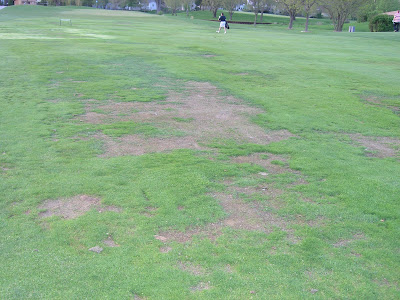In Chicago, we had long periods of snow cover and 97 days with high tempuratures under 50 degrees. We also had a slow thaw that may have soaked low areas. Because of this, many lawns and turf areas have spots of pink snow mold, gray snow mold, or water damage. A friend called me the other day in a panic because his landscaper told him he had snow mold. The landscaper wasn't wrong: Everyone has snow mold this year! Turf authorities do not recommend chemical treatments, except in very extreme cases, because your lawn will most likely recover once the grass starts growing.
The following was written in 2005, but is just as relevant this year:
Winter has definitely been a long one this year in Michigan and if I had to guess, I think we will definitely see some snow mold in some turf areas. There might be some pink snow mold and in other areas some gray snow mold. Whichever is your favorite color, I wouldn’t get too worked up over the symptoms you’ll see. Gray snow mold is typically seen in turf areas that were under snow cover for extended periods of time. The damage from either type of snow mold is typically restricted to the leaf tissue and once the temperature starts to warm, the turf will start growing and recover from the damage quickly. (Dr. Kevin Frank, Michigan State)Most bluegrass lawns and golf course rough have been affected to some extent by gray snow mold. Most places, this fungus only affected the blades of the plant and will not affect the health of the turf long-term. Areas affected by gray snow mold have a matted down appearance. The blades look like they are glued together, and pin-head sized sclerotia (fungal structures) can often be seen. By now, this disease is inactive and can do no further damage. The best thing to do: Wait for it to dry out, use a rake to break up the matted areas, and wait for new blades to come up. Most of the time, seeding isn't necessary.
Pink snow mold can be a little more damaging. We have seen some spots at the golf course:
 |
| Pink Snow Mold spots |
The slow thaw and large amounts of moisture this past month may cause a less interesting, but more common problem: flood damage. Some areas have been under water or ice for a long period. When the turf in these areas warm up and come out of dormancy while underwater, flood damage can occur. It is too early to say, but I suspect damage of this kind will be common this year throughout Chicagoland.
 |
| Spring water damage several years ago |
So what is the answer to my initial question -- "what can we do about it?" Nothing fancy, really: Wait, rake it, seed it, mow it, and enjoy it!
Added 3/16/2010: I ran across some great pictures of snow mold from the Chicago area. Check them out for more information. (Link)











No comments:
Post a Comment